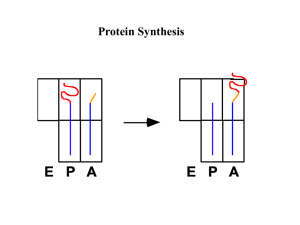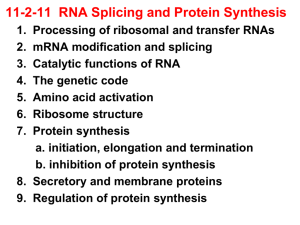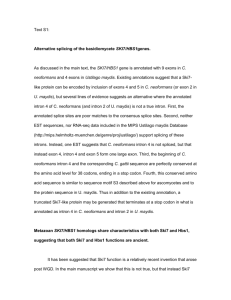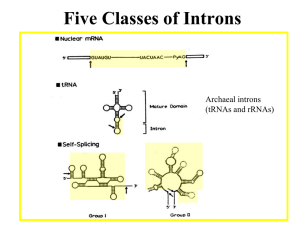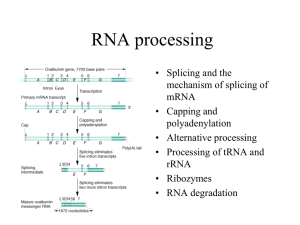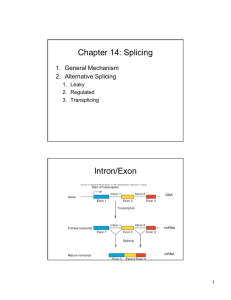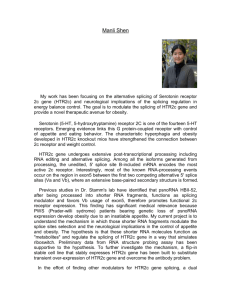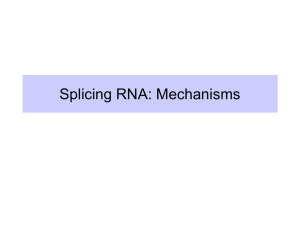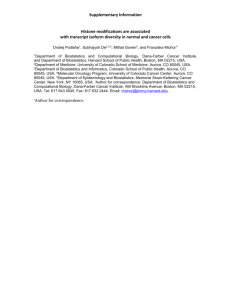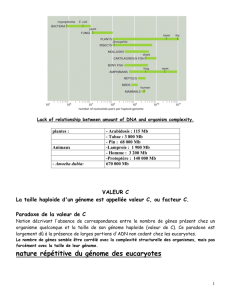CHAPTER FOUR
advertisement
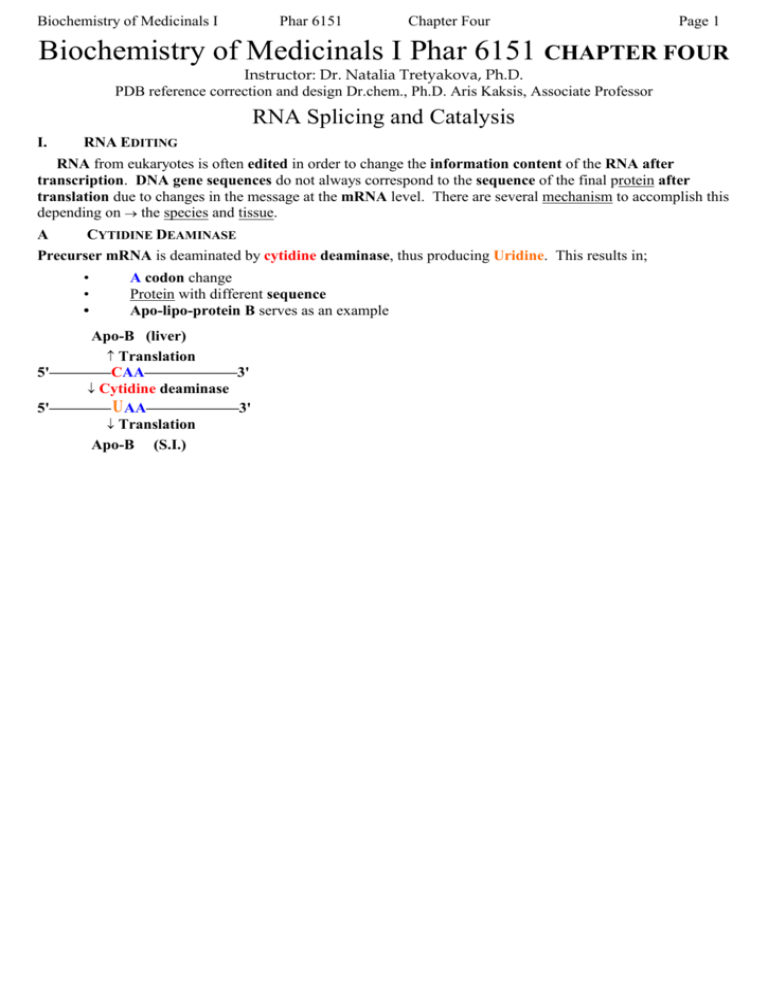
Biochemistry of Medicinals I Phar 6151 Chapter Four Page 1 Biochemistry of Medicinals I Phar 6151 CHAPTER FOUR Instructor: Dr. Natalia Tretyakova, Ph.D. PDB reference correction and design Dr.chem., Ph.D. Aris Kaksis, Associate Professor RNA Splicing and Catalysis I. RNA EDITING RNA from eukaryotes is often edited in order to change the information content of the RNA after transcription. DNA gene sequences do not always correspond to the sequence of the final protein after translation due to changes in the message at the mRNA level. There are several mechanism to accomplish this depending on the species and tissue. A CYTIDINE DEAMINASE Precurser mRNA is deaminated by cytidine deaminase, thus producing Uridine. This results in; • • • A codon change Protein with different sequence Apo-lipo-protein B serves as an example Apo-B (liver) Translation 5'————CAA——————3' Cytidine deaminase 5'———— U AA——————3' Translation Apo-B (S.I.) Biochemistry of Medicinals I Phar 6151 B. Chapter Four Page 2 RNA Splicing DNA sequences of genes from eukaryotes often harbor regions that are not translated, or intron. Introns "intervene" between portions of sequence that is translated or "expressed" referred to as exons. Therefore, the mRNA must be modified in order to remove the introns before translation. This is accomplished by splicing. 1. Requirements: • • • • An central A 5' end needs AGGUAAGU 3' end needs (Py)nNCAGG A series of snRNPs (small nuclear ribo-nucleo-protein particles) referred to as splicesome Splicing Signals Intron Upstream Exon Downstream Exon 5' ||||||||||||||||||||||||||AGGUAAGU————A——————(Py)nNCAGG|||||||||||||||||||||||||||||||| 3' 5' Splice Site Branch Site 3' Splice Site 2. Mechanism The mechanism of splicing for exon coupling and intron extrusion depends on two 2 trans-esterification reactions, which result in a lariat form or RNA and the product. Upstream Exon UGAAUGGA|||||||||||||||||||||||||| 5' O | Downstream Exon ————A——————(Py)nNCAGG|||||||||||||||||||||||||||||||| 3' Splice 3' Site Upstream Exon GA|||||||||||||||||||||||||| 5' UGAAUG O—PO2 O / O Downstream Exon ————A——————(Py)nNCAGG|||||||||||||||||||||||||||||||| 3' Splice 3' Site U GAA U G O—PO2 / O ————A——————(Py)nNCAG—O Lariat Intron Upstream Exon Downstream Exon 5' ||||||||||||||||||||||||||AGG|||||||||||||||||||||||||||||||| 3' Spliceed Product of Exons • The branching associated with the A of the lariat form contains two 2 phospho-di-ester linkages to the 2' and 3' of the A. Biochemistry of Medicinals I Phar 6151 H H O 5' H O 3' Chapter Four Page 3 N H H N A N N N 2' Lariat H O H H O O 5' H 3' O O G O STRUCTURE OF BRANCH O H O H 3. Base Spliceosomes The spliceo-some which catalyzes the splicing reaction is composed of the following species, which are small proteins made up of RNA and protein. • Segments of RNA play a key role in directing the alignment splice sites and in catalysis •ATP-powered proteins unwind RNA duplex intermediates thus causing the release of snRNPs from the products snRNP U1 U2 U5 U4 U6 II. Role Binds the 5' splice site and then the 3' splice site Binds the branch site and forms part of the catalytic center Binds the 5' splice site Masks the catalytic activity of U6 Catalyzes splicing RNA CATALYSIS Biological catalysis always takes place in the presence of an enzyme or protein that is engineered to catalyze the reaction in question. Recently, this dogma has been challenged since it has been shown that RNA can self splice without the assistance of proteins. These RNAs are referred to as Ribozymes. They were first 1st isolated from the ciliated protozoan, Tetrahymena. A. CHARACTERISTICS • Need a cofactor; GMP, GDP or GTP • Two 2 trans-esterification reactions occur • Divalent 2 valent cation is required Mg2+ • Reaction is highly stereospecific Biochemistry of Medicinals I Phar 6151 Chapter Four Page 4 MECHANISM OF RIBOZYME SELF SPLICING G G \ | 5' Upstream Exon O | ||||||||||||||||||||||||||||CUCUCUA P Downstream Exon 3' AGGGAGG G||||||||||||||||||||||||||||||||||| G 5' Upstream Exon 3' \ ||||||||||||||||||||||||||||CUCUCU—O P Downstream Exon 3' AGGGAGGAG 5' G||||||||||||||||||||||||||||||||||| G 3' | O AGGGAGGAG 5' 5' ||||||||||||||||||||||||||||CUCUCUG|||||||||||||||||||||||||||||||||| 3' Linear Intron Spliceed Product of Exons Short sequences which function as ribozymes have been isolated from various plant viruses. The are called hammerhead ribozymes because of their resemblance to the head of a hammer. They will effectively bind an RNA molecule and carry out on cleavage reaction. In this reaction the two 2 pieces are not joined by an additional trans-esterification. Ribozyme /-----A------\ U G | | G U | | /-A C-\ CGCGG AGCUCGG-ppp GCGCC UCGAGC \-G-A-A-A=U-C-/ Cleavage Site CG /-A==U-\ C G \----C---/ Substrate
